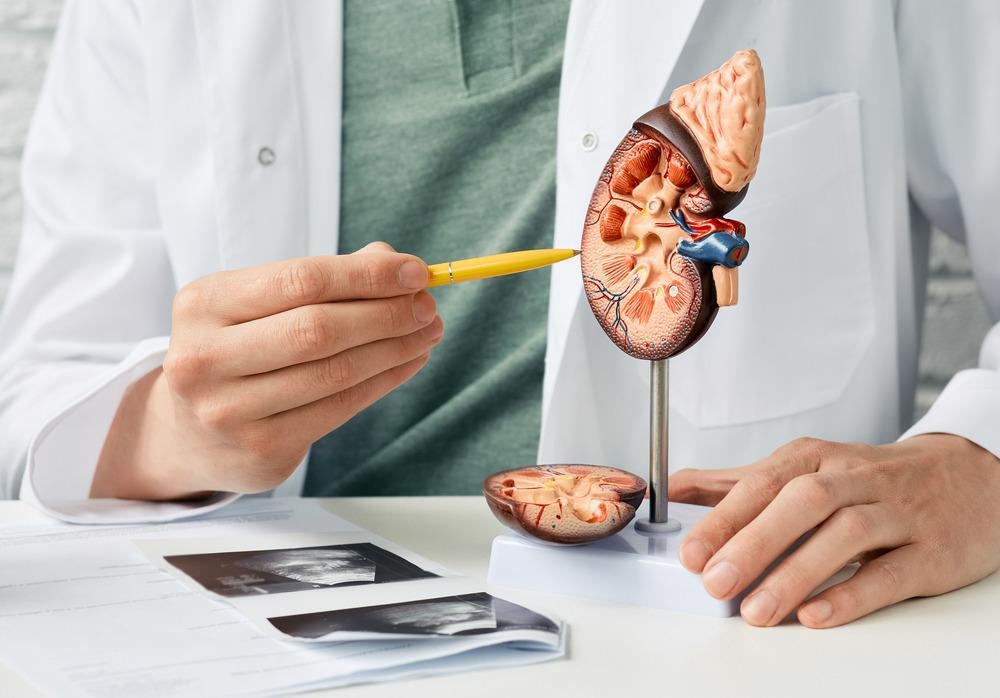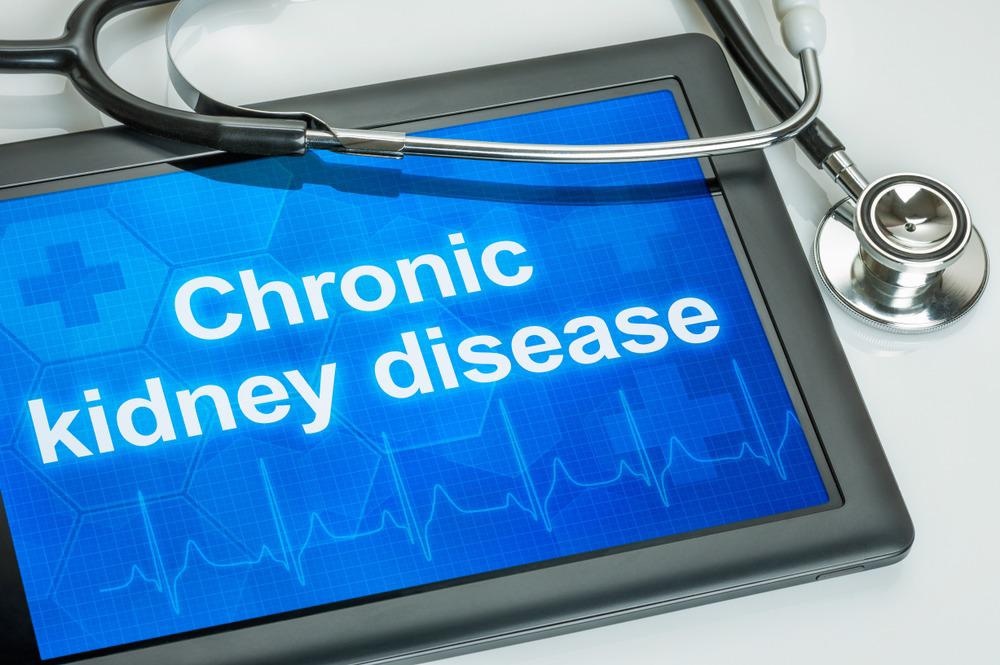Currently, approaching 700 million people across the world have chronic kidney disease, with the numbers increasing yearly; worldwide, the burden continues to rise. Chronic kidney disease is a major threat to public health; the World Health Organization ranked CKD as the 10th most common cause of death – an endemic that is most marked in low-income and lower-middle-income countries, where appropriate measures, infrastructure, and resources for treating patients with advanced chronic kidney disease are insufficient.

Image Credit: Peakstock/Shutterstock.com
Chronic kidney disease has often been neglected across national healthcare strategy considerations, predominantly being associated with a lack of awareness and understanding among key stakeholders including patients, healthcare professionals, and policymakers.
There is a significant unmet medical need for chronic kidney disease. Chronic kidney disease is a non-communicable condition that is categorized into five stages of severity; it often remains undetected in its earlier stages. The final stage of the condition is kidney failure, but for patients who have been diagnosed with chronic kidney disease, kidney function declines with time. Alarmingly, renal functional capacity can decline to 90% before symptoms appear. As patients with chronic kidney disease progressively decline to stage liver failure, there is an increased urgency for dialysis or kidney transplantation. Both of these treatment options are significantly invasive, time-consuming, and present a large economic burden.
Chronic Kidney Disease Cure is Costly
The prevalence of chronic kidney disease, while a global threat, is most pronounced in its growth in low income and low middle-income countries (LLMICs); within high-income countries (HICs), it is found to be most pronounced amongst the most disadvantaged, often indigenous communities who are often excluded from care systems as access is significantly curtailed.
Cost, leadership, workforce, and structural elements of healthcare present the most notable barriers to accessing kidney health care in LLMICs; however, the impact of the cost of care and treatment as well as excessive point of service payment systems affect patients most directly, producing the most devastating outcomes.
Governments cover costs for dialysis in HICs, however, patients in LLMICs are often burdened with the responsibility of partly, or fully covering the cost of their treatment out of pocket. For example, one study has estimated that in Kenya, Senegal, and Nigeria, the annual cost of hemodialysis (in international dollars) is $1.7 billion, $3.5 billion, and $450 million, respectively; this maps to 15.2 percent 55.8% and 35.8% of the total domestic government health costs of these countries.
Moreover, chronic kidney disease – even in its earliest stages – significantly increases the risk of developing cardiovascular disease. An additional aggravator of mounting healthcare costs and burdens associated with progressive disease are the modalities of kidney replacement therapies which encompass peritoneal dialysis and kidney transplantation, which are unavailable in many LLMICs. Relative to HICs, peritoneal dialysis on kidney transplantation availability represented an availability of 0.5 per million population (pmp) (23% of LLMICs) vs. 53.0 pmp (89% of HICs).
What is the Goal of Early Chronic Kidney Disease Detection?
The goals of early detection are to prevent the progression of chronic kidney disease and its associated complications, with subsequent improvements in patient outcomes and reductions in the impact of chronic kidney disease on healthcare resources.
The Rationale for Early Detection
The basis for implementing urgent action of chronic kidney disease is improved patient outcomes through the identification of high-risk groups, resulting in targeted therapy implementation which subsequently would reduce the incidence of adverse and costly effects such as progression to end-stage renal disease, cardiovascular events, and mortality.
Early detection of chronic kidney disease has a notable impact in developing countries where both dialysis and transplant facilities are severely limited; as such it is hoped to have an especially noticeable effect on curtailing progression to end-stage renal disease, with a general increase in overall population health due to the decreased development of comorbidities. In addition to these effects, drug safety and potential toxic outcomes are also improved with early identification of kidney dysfunction, with potential downstream savings accumulating for both healthcare institutions and individuals.
Indeed, increased costs associated with treating chronic kidney disease result from high rates of comorbidity-driven admission and extended hospital stays that are associated with chronic kidney disease progression. Therefore, the costs accumulated during the early stages of chronic kidney disease accumulate as the condition progresses to end-stage renal disease and continue to remain very high after. The combination of increased awareness of chronic kidney disease among healthcare professionals and its subsequent timely intervention will result in improved economic and clinical outcomes.
Relatively few studies have quantitatively outlined potential cost savings of cat strategies for improved outcomes. However, extrapolating from other screening programs implemented for a range of chronic conditions such as diabetes, cancer, and cardiovascular disease, suggest that timely and rapid treatment is a compelling and impactful strategy.

Image Credit: Zerbor/Shutterstock.com
How is Chronic Kidney Disease Diagnosed?
Chronic kidney disease is clinically defined as evidence of impaired function or damage to kidney structure and/or declined function, as characterized by a reduction of estimated glomerular filtration rate (eGFR) that is sustained for at least 3 months.
Demonstrating the Impact of Early Detection and Intervention
Due to this high cost of kidney replacement therapy, there is a growing need to prioritize preventative strategies to delay the inevitable progression to kidney failure, rather than expand therapeutic services. To affect this change, implementation of both cost-effective and efficient screening and early detection strategies, alongside treatment programs that are aimed at delaying progression to end-stage renal failure is necessary.
Several studies have demonstrated that this is a possibility; in a study conducted in Nepal, 3 years of treatment were initiated in 4471 out of 20,811 patients screened for chronic kidney disease who was found to have diabetes, proteinuria, hypertension, or impaired kidney function, experienced significant improvements in the chronic kidney disease. Patients were treated via low-cost antihypertensives, anti-diabetic medication, or angiotensin-converting enzyme inhibitors (ACE-i); 63% showed decreased to normal dipstick positive proteinuria, and 48% of those with mild to moderately impaired kidney function at baseline showed stabilization or improvement. This study highlights the impact of early disease detection and subsequent early intervention treatments for reducing or eliminating the progression of chronic kidney disease and associated cardiovascular morbidity and mortality.
Early detection on screening programs is used in HICs more routinely to assess disease burden and initiate tools and programs to improve kidney health and subsequent progression to later-stage which require costly therapeutic interventions and improve cardiovascular outcomes. At present, these measures have demonstrated a lack of effectiveness as there is a lack of overall benefits and an absence of cost-effective proof.
Prevention being better than a cure is a widespread ideology in medicine, however, this notion is considered to be more effective if preventative strategies target subgroups identified to be at greater risk of harm. Screening and early detection of chronic kidney disease are believed to produce better health outcomes as both patients and caregivers can actively use tools and knowledge to decelerate progression to end-stages and improve outcomes. However, this intuitive assumption has not been realized, on is prompted ‘to screen or not to screen’ debate in the nephrology setting.
The consensus emerging from the conference on ‘early identification and interventions in CKD’ organized by Kidney Disease Improving Global Outcomes (KDIGO) was that CKD screening coupled with risk stratification and treatment should be implemented in primary or community care settings for high-risk persons. In line with this, nephrology groups have developed guidelines for screening for chronic kidney disease which are specific to populations with differentiating strategies directed towards specific subgroups, recommended tests to use, and the frequency of testing necessary.
Consequences of Early Detection
Alongside detection of kidney function, additional investigations are also necessary to determine the etiology of kidney disease. Several patients may have identifiable causes of chronic kidney disease, such as hypertension, diabetes, or inherited kidney disease; however, subgroups do not and require further testing. Other ancillary data, such as urine protein extraction unnecessary before a diagnosis of chronic kidney disease can be made.
One of the most notable benefits of early detection is increased exposure to therapeutic interventions that either delay or ameliorate the probability of adverse outcomes. There are also benefits to early detection at earlier stages of the care cascade. Currently, there is no consensus on what is defined as a timely referral; however, early identification can contribute towards avoiding episodes of acute kidney injury and the build-up of nephrotoxins, therefore referring all patients to a nephrology clinic at the point of identification is deemed appropriate.
However, this can become overwhelming for healthcare systems, so guidelines typically restrict referral to nephrology clinics for patients who have an eGFR of <30ml/min. Referral to a nephrology clinic can facilitate an understanding of the etiology of the patient's chronic kidney disease, which has subsequent implications for treatment choices on prognosis. It may also facilitate strategies to delay progression.
The early identification of chronic kidney disease has numerous benefits including increasing the amount of time that patients can undergo therapy which has been proven to confer several benefits. This early exposure to treatment has several downstream effects; avoiding nephrotoxic effects of drugs and more invasive procedures such as contrast-based imaging comment which in turn improves patient safety; and, finally decreasing the risk of patients developing acute kidney injury episodes.
These improvements subsequently need to a reduction in the use of and improved health for chronic kidney disease patients.
However, there is already a burden of chronic kidney disease, currently at epidemic proportion, and expected to increase further in both developing and developed countries. Therefore, improvement in chronic kidney disease detection, as well as improved methods to project prognostic outcomes and improved treatment strategies are necessary. This is occurring against a backdrop of increasing incidence of comorbidities such as diabetes in the developing world, alongside exposure to drug therapies and infections, therefore the need to ensure early identification of chronic kidney disease at the earliest time point possible is imperative.
References:
- Levin A, Stevens PE. Early detection of CKD: the benefits, limitations, and effects on prognosis. Nat Rev Nephrol. 2011;7(8):446-57. doi: 10.1038/nrneph.2011.86.
- Okpechi IG, Caskey FJ, Gaipov A, et al. Assessing the impact of screening, early identification and intervention programs for chronic kidney disease: protocol for a scoping review. BMJ Open. 2021;11(12):e053857. doi: 10.1136/bmjopen-2021-053857.
- Sharma SK, Ghimire A, Carminati S, et al. Management of chronic kidney disease and its risk factors in eastern Nepal. Lancet Glob Health 2014;2:e506–7. doi:10.1016/S2214-109X(14)70281-5.
- Crosby L, Baker P, Hangoma P, et al. Dialysis in Africa: the need for evidence-informed decision making. Lancet Glob Health 2020;8:e476–7. doi:10.1016/S2214-109X(20)30058-9pmid.
- Cho Y, Bello AK, Levin A, et al. Peritoneal dialysis use and practice patterns: an international survey study. Am J Kidney Dis 2021;77:315–25. doi:10.1053/j.ajkd.2020.05.032pmid.
- Bello AK, Levin A, Lunney M, et al. Status of care for end stage kidney disease in countries and regions worldwide: international cross sectional survey. BMJ 2019;367:l5873. doi:10.1136/bmj.l5873pmid.
- Fink HA, Ishani A, Taylor BC. Screening for, monitoring, and treatment of chronic kidney disease stages 1 to 3: a systematic review for the U. S. Preventive Services Task Force and for an American College of Physicians Clinical Practice Guideline. Annals of internal medicine 2012;156:570–81.
- Kliger AS. Screening for CKD: a pro and con debate. Clin J Am Soc Nephrol 2014;9:1987. doi:10.2215/CJN.08990914
Further Reading
Last Updated: Mar 8, 2022